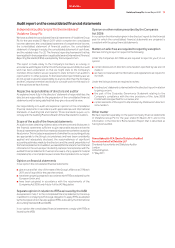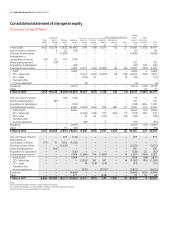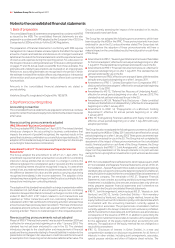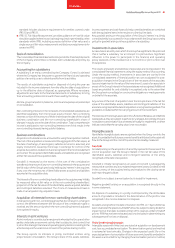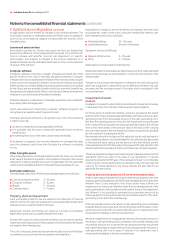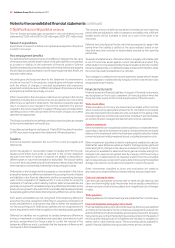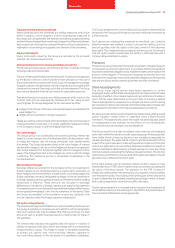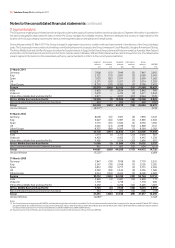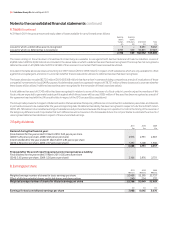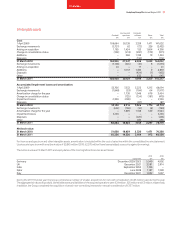Vodafone 2011 Annual Report Download - page 90
Download and view the complete annual report
Please find page 90 of the 2011 Vodafone annual report below. You can navigate through the pages in the report by either clicking on the pages listed below, or by using the keyword search tool below to find specific information within the annual report.88 Vodafone Group Plc Annual Report 2011
Notes to the consolidated nancial statements continued
The carrying amount of deferred tax assets is reviewed at each reporting
period date and adjusted to reflect changes in probability that sufficient
taxable profits will be available to allow all or part of the asset to be
recovered.
Deferred tax is calculated at the tax rates that are expected to apply in the
period when the liability is settled or the asset realised, based on tax
rates that have been enacted or substantively enacted by the reporting
period date.
Tax assets and liabilities are offset when there is a legally enforceable right
to set off current tax assets against current tax liabilities and when they
either relate to income taxes levied by the same taxation authority on either
the same taxable entity or on different taxable entities which intend to settle
the current tax assets and liabilities on a net basis.
Tax is charged or credited to the income statement, except when it relates
to items charged or credited directly to equity, in which case the tax is also
recognised directly in equity.
Financial instruments
Financial assets and financial liabilities, in respect of financial instruments,
are recognised on the Group’s statement of financial position when the
Group becomes a party to the contractual provisions of the instrument.
Trade receivables
Trade receivables do not carry any interest and are stated at their nominal
value as reduced by appropriate allowances for estimated irrecoverable
amounts. Estimated irrecoverable amounts are based on the ageing of the
receivable balances and historical experience. Individual trade receivables
are written off when management deems them not to be collectible.
Other investments
Other investments are recognised and derecognised on a trade date where
a purchase or sale of an investment is under a contract whose terms require
delivery of the investment within the timeframe established by the market
concerned, and are initially measured at cost, including transaction costs.
Other investments classified as held for trading and available-for-sale are
stated at fair value. Where securities are held for trading purposes, gains and
losses arising from changes in fair value are included in net profit or loss for
the period. For available-for-sale investments, gains and losses arising from
changes in fair value are recognised directly in equity, until the security is
disposed of or is determined to be impaired, at which time the cumulative
gain or loss previously recognised in equity, determined using the weighted
average cost method, is included in the net profit or loss for the period.
Other investments classified as loans and receivables are stated at
amortised cost using the effective interest method, less any impairment.
Cash and cash equivalents
Cash and cash equivalents comprise cash on hand and call deposits, and
other short-term highly liquid investments that are readily convertible to
a known amount of cash and are subject to an insignificant risk of changes
in value.
Trade payables
Trade payables are not interest bearing and are stated at their nominal value.
Financial liabilities and equity instruments
Financial liabilities and equity instruments issued by the Group are classified
according to the substance of the contractual arrangements entered into
and the definitions of a financial liability and an equity instrument. An equity
instrument is any contract that evidences a residual interest in the assets of
the Group after deducting all of its liabilities and includes no obligation to
deliver cash or other financial assets. The accounting policies adopted for
specific financial liabilities and equity instruments are set out below.
2. Signicant accounting policies continued
The net foreign exchange gain recognised in the consolidated income
statement is £1,022 million (2010: £35 million gain, 2009: £131 million loss).
Research expenditure
Expenditure on research activities is recognised as an expense in the period
in which it is incurred.
Post employment benets
For defined benefit retirement plans, the difference between the fair value
of the plan assets and the present value of the plan liabilities is recognised
as an asset or liability on the statement of financial position. Scheme
liabilities are assessed using the projected unit funding method and applying
the principal actuarial assumptions at the reporting period date. Assets are
valued at market value.
Actuarial gains and losses are taken to the statement of comprehensive
income as incurred. For this purpose, actuarial gains and losses comprise
both the effects of changes in actuarial assumptions and experience
adjustments arising because of differences between the previous actuarial
assumptions and what has actually occurred.
Other movements in the net surplus or deficit are recognised in the income
statement, including the current service cost, any past service cost and the
effect of any curtailment or settlements. The interest cost less the expected
return on assets is also charged to the income statement. The amount
charged to the income statement in respect of these plans is included within
operating costs or in the Group’s share of the results of equity accounted
operations as appropriate.
The Group’s contributions to defined contribution pension plans are charged
to the income statement as they fall due.
Cumulative actuarial gains and losses at 1 April 2004, the date of transition
to IFRS, have been recognised in the statement of financial position.
Taxation
Income tax expense represents the sum of the current tax payable and
deferred tax.
Current tax payable or recoverable is based on taxable profit for the year.
Taxable profit differs from profit as reported in the income statement
because some items of income or expense are taxable or deductible in
different years or may never be taxable or deductible. The Group’s liability
for current tax is calculated using UK and foreign tax rates and laws that have
been enacted or substantively enacted by the reporting period date.
Deferred tax is the tax expected to be payable or recoverable in the future
arising from temporary differences between the carrying amounts of assets
and liabilities in the financial statements and the corresponding tax bases
used in the computation of taxable profit. It is accounted for using the
statement of financial position liability method. Deferred tax liabilities are
generally recognised for all taxable temporary differences and deferred tax
assets are recognised to the extent that it is probable that taxable profits will
be available against which deductible temporary differences can be utilised.
Such assets and liabilities are not recognised if the temporary difference
arises from the initial recognition (other than in a business combination) of
assets and liabilities in a transaction that affects neither the taxable profit
nor the accounting profit. Deferred tax liabilities are not recognised to the
extent they arise from the initial recognition of non tax deductable goodwill.
Deferred tax liabilities are recognised for taxable temporary differences
arising on investments in subsidiaries and associates, and interests in joint
ventures, except where the Group is able to control the reversal of the
temporary difference and it is probable that the temporary difference will
not reverse in the foreseeable future.



